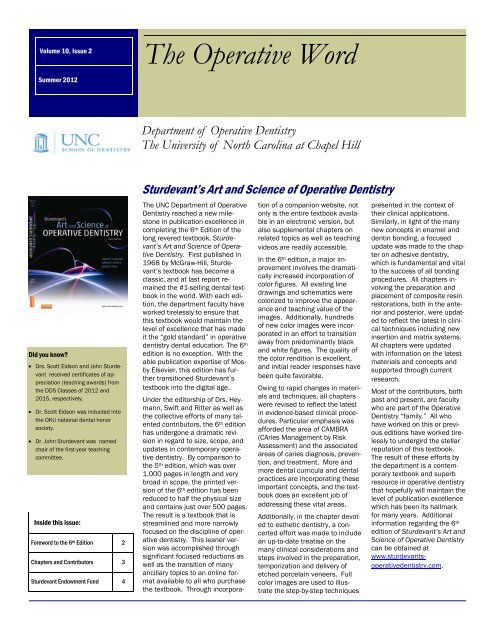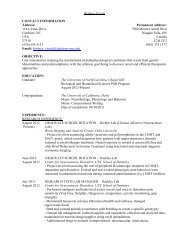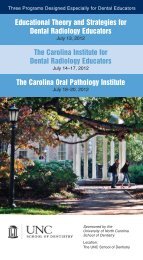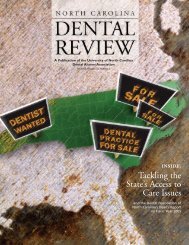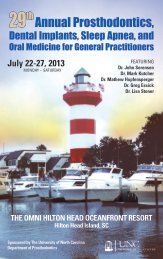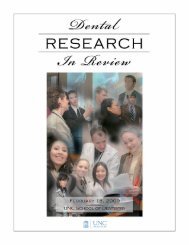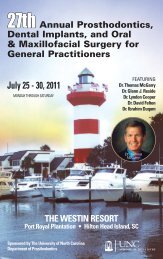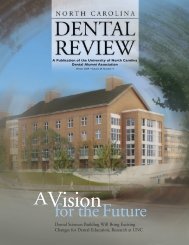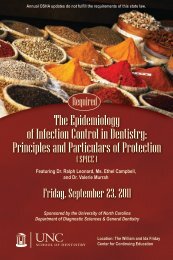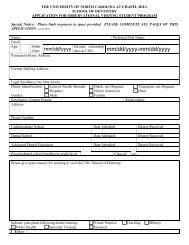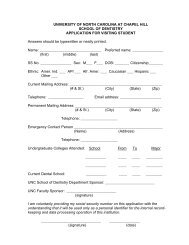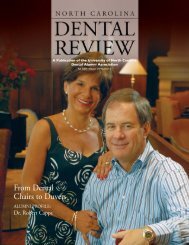The Operative Word - UNC School of Dentistry - The University of ...
The Operative Word - UNC School of Dentistry - The University of ...
The Operative Word - UNC School of Dentistry - The University of ...
Create successful ePaper yourself
Turn your PDF publications into a flip-book with our unique Google optimized e-Paper software.
Volume 10, Issue 2Volume 10, Issue 2Summer 2012Summer 2012<strong>The</strong> <strong>Operative</strong> <strong>Word</strong><strong>The</strong> <strong>Operative</strong> <strong>Word</strong>Department <strong>of</strong> <strong>Operative</strong> <strong>Dentistry</strong><strong>The</strong> <strong>University</strong> <strong>of</strong> North Carolina at Chapel HillDid you know? Drs. Scott Eidson and John Sturdevantreceived certificates <strong>of</strong> appreciation(teaching awards) fromthe DDS Classes <strong>of</strong> 2012 and2015, respectively. Dr. Scott Eidson was inducted intothe OKU national dental honorsociety. Dr. John Sturdevant was namedchair <strong>of</strong> the first-year teachingcommittee.Inside this issue:Foreword to the 6 th Edition 2Chapters and Contributors 3Sturdevant Endowment Fund 4Sturdevant’s Art and Science <strong>of</strong> <strong>Operative</strong> <strong>Dentistry</strong><strong>The</strong> <strong>UNC</strong> Department <strong>of</strong> <strong>Operative</strong><strong>Dentistry</strong> reached a new milestonein publication excellence incompleting the 6 th Edition <strong>of</strong> thelong revered textbook, Sturdevant’sArt and Science <strong>of</strong> <strong>Operative</strong><strong>Dentistry</strong>. First published in1968 by McGraw-Hill, Sturdevant’stextbook has become aclassic, and at last report remainedthe #1-selling dental textbookin the world. With each edition,the department faculty haveworked tirelessly to ensure thatthis textbook would maintain thelevel <strong>of</strong> excellence that has madeit the “gold standard” in operativedentistry dental education. <strong>The</strong> 6 thedition is no exception. With theable publication expertise <strong>of</strong> MosbyElsevier, this edition has furthertransitioned Sturdevant’stextbook into the digital age.Under the editorship <strong>of</strong> Drs. Heymann,Swift and Ritter as well asthe collective efforts <strong>of</strong> many talentedcontributors, the 6 th editionhas undergone a dramatic revisionin regard to size, scope, andupdates in contemporary operativedentistry. By comparison tothe 5 th edition, which was over1,000 pages in length and verybroad in scope, the printed version<strong>of</strong> the 6 th edition has beenreduced to half the physical sizeand contains just over 500 pages.<strong>The</strong> result is a textbook that isstreamlined and more narrowlyfocused on the discipline <strong>of</strong> operativedentistry. This leaner versionwas accomplished throughsignificant focused reductions aswell as the transition <strong>of</strong> manyancillary topics to an online formatavailable to all who purchasethe textbook. Through incorporation<strong>of</strong> a companion website, notonly is the entire textbook availablein an electronic version, butalso supplemental chapters onrelated topics as well as teachingvideos are readily accessible.In the 6 th edition, a major improvementinvolves the dramaticallyincreased incorporation <strong>of</strong>color figures. All existing linedrawings and schematics werecolorized to improve the appearanceand teaching value <strong>of</strong> theimages. Additionally, hundreds<strong>of</strong> new color images were incorporatedin an effort to transitionaway from predominantly blackand white figures. <strong>The</strong> quality <strong>of</strong>the color rendition is excellent,and initial reader responses havebeen quite favorable.Owing to rapid changes in materialsand techniques, all chapterswere revised to reflect the latestin evidence-based clinical procedures.Particular emphasis wasafforded the area <strong>of</strong> CAMBRA(CAries Management by RiskAssessment) and the associatedareas <strong>of</strong> caries diagnosis, prevention,and treatment. More andmore dental curricula and dentalpractices are incorporating theseimportant concepts, and the textbookdoes an excellent job <strong>of</strong>addressing these vital areas.Additionally, in the chapter devotedto esthetic dentistry, a concertedeffort was made to includean up-to-date treatise on themany clinical considerations andsteps involved in the preparation,temporization and delivery <strong>of</strong>etched porcelain veneers. Fullcolor images are used to illustratethe step-by-step techniquespresented in the context <strong>of</strong>their clinical applications.Similarly, in light <strong>of</strong> the manynew concepts in enamel anddentin bonding, a focusedupdate was made to the chapteron adhesive dentistry,which is fundamental and vitalto the success <strong>of</strong> all bondingprocedures. All chapters involvingthe preparation andplacement <strong>of</strong> composite resinrestorations, both in the anteriorand posterior, were updatedto reflect the latest in clinicaltechniques including newinsertion and matrix systems.All chapters were updatedwith information on the latestmaterials and concepts andsupported through currentresearch.Most <strong>of</strong> the contributors, bothpast and present, are facultywho are part <strong>of</strong> the <strong>Operative</strong><strong>Dentistry</strong> “family.” All whohave worked on this or previouseditions have worked tirelesslyto undergird the stellarreputation <strong>of</strong> this textbook.<strong>The</strong> result <strong>of</strong> these efforts bythe department is a contemporarytextbook and superbresource in operative dentistrythat hopefully will maintain thelevel <strong>of</strong> publication excellencewhich has been its hallmarkfor many years. Additionalinformation regarding the 6 thedition <strong>of</strong> Sturdevant’s Art andScience <strong>of</strong> <strong>Operative</strong> <strong>Dentistry</strong>can be obtained atwww.sturdevantsoperativedentistry.com.
Page 2<strong>The</strong> <strong>Operative</strong> <strong>Word</strong>Foreword to the 6 th EditionEditor’s note: Dean Emeritus Dr.John Stamm contributed theforeword to the 6 th edition <strong>of</strong> theSturdevant’s textbook. It is reproducedhere in its entirety.Not long ago I picked up and readCharles Pappas’ lively 1983 account<strong>of</strong> “<strong>The</strong> Life and Times <strong>of</strong>G.V. Black.” I rapidly marveled atthe scintillating accomplishments<strong>of</strong> a man whose only dental trainingcomprised a few weeks as anapprentice to a Mount Sterling,Illinois, dentist. Often referred toas the father <strong>of</strong> <strong>Operative</strong> <strong>Dentistry</strong>,Greene Vardiman Black wasborn in 1836, and opened hisfirst dental practice in 1857, inWinchester IL. Coincident withstarting his practice, G.V. Blackimposed on himself a rigorousself-education routine, focusedprimarily on the basic sciencesthat were emerging or developingso impressively during most <strong>of</strong>the 1800s. Utilizing a few precioushours each evening, afterhis children had been sent tobed, Black began intensive studies<strong>of</strong> chemistry, microbiology,and pathology. At that time most<strong>of</strong> the books and scientific essaysavailable to Black were authoredby Europeans, some writing inEnglish, but many in Latin, Germanand French. Consequently,Black studied these foreign languagesuntil he was sufficientlypr<strong>of</strong>icient to absorb the sciencehe needed in order to advance inhis chosen pr<strong>of</strong>essional and earlyacademic life.Beginning in the mid-1860s,Black began to apply what hedrew from his basic science studies,and started to publish increasinglylearned articles aboutvarious facets <strong>of</strong> <strong>Dentistry</strong>. Withhis dental experience growing,and his academic capabilitiesevermore obvious, Black wasinvited in 1866 to become afounding trustee <strong>of</strong> the MissouriDental College, where he subsequentlytaught from 1870 to1881. In 1877 Black was awardedan honorary DDS by the MissouriDental College, and in 1884he received an honorary MD degreefrom the Chicago MedicalCollege (later to become Northwestern<strong>University</strong> Medical<strong>School</strong>). In 1883 Black had begunto teach at the Chicago College<strong>of</strong> Dental Surgery as Pr<strong>of</strong>essor<strong>of</strong> Dental Pathology and Bacteriology.In 1897, G.V. Blackbecame Dean and Pr<strong>of</strong>essor <strong>of</strong><strong>Operative</strong> <strong>Dentistry</strong>, Dental Pathologyand Bacteriology at theNorthwestern <strong>University</strong> Dental<strong>School</strong>, a position he held for 17years. Black died on August 31,1915.Black himself published sixbooks, <strong>of</strong> which his magnumopus was <strong>Operative</strong> <strong>Dentistry</strong>:Volumes I and II (1908). Quicklyreceiving wide acclaim, that workwas revised and republishedseven times over the period <strong>of</strong> ahalf-century. What would G. V.Black say if today he were handed,and asked for comments on,the sixth edition <strong>of</strong> Sturdevant’sArt and Science <strong>of</strong> <strong>Operative</strong><strong>Dentistry</strong>? My guess is thatBlack would, first <strong>of</strong> all, expressquiet satisfaction that as a science<strong>Operative</strong> <strong>Dentistry</strong> hasmade so much progress thatsome <strong>of</strong> the key, enduring principleshe enunciated were no longerrelevant, having been overtakenby modern science and technology.An example would beBlack’s famous principle <strong>of</strong> extensionfor prevention, a dictumno longer followed because <strong>of</strong>the improvements in oral hygiene,fluoride therapy, remineralizationformulations, and fissuresealants, that together havegreatly reduced the incidenceand severity <strong>of</strong> recurrent caries.I think that Black would also bepleased that the authors collaboratingon Sturdevant’s sixth editionhave retained the impressivelycomprehensive nature <strong>of</strong>this textbook. With his own backgroundin microbiology and pathology,Black would have seenas very relevant the extensivecoverage devoted to anatomy,histology, physiology, microbiologyand cariology within the <strong>Operative</strong><strong>Dentistry</strong> framework. Forexample, and as is more apparentthan ever, modern cariologyhas become a fast moving fieldwith changing ideas on etiology,detection, measurement, riskassessment, prevention andtreatment <strong>of</strong> caries. Sturdevant’seditors and co-authors fully immersethemselves in such topics,and skillfully blend and presentthe established understandingswith the new, emerging scientificdevelopments.Black was also a student <strong>of</strong>chemistry and materials science.He carefully studied the chemistry<strong>of</strong> dental cements, and heshared his findings via manyscientific publications. Blackconducted numerous studies onamalgams, their composition andproperties. <strong>The</strong>se experimentswere also written up and published.Because <strong>of</strong> the centralplace amalgams held in dentalpractice a century ago, I thinkBlack would be astounded by theenormous role adhesive resinsand various composite restorativematerials play today in contemporary<strong>Operative</strong> <strong>Dentistry</strong>.<strong>The</strong> transition from amalgam tonon-metallic restorations is farfrom complete, yet the adhesivedentistry revolution has beenaccompanied by modifications <strong>of</strong>G. V. Black’s venerable six principles<strong>of</strong> cavity preparation, asoriginally codified in 1908. Blackwould surely think <strong>of</strong> this as adefinitive and welcome sign <strong>of</strong>dentistry’s scientific progress, agoal for which he always advocated.Black would likely be impressedby the functional and greatlyimproved esthetic results achievablewith the modern compositerestorative materials. Yet it isprobably safe to assume thatBlack the scientist would urgeeven more research to developstill better dental materials withwhich to treat patients, andthereby improve the public’shealth. That is the type <strong>of</strong> challengethe sixth edition <strong>of</strong> Sturdevant’s<strong>Operative</strong> <strong>Dentistry</strong> hasembraced, and represents thetype <strong>of</strong> vision and spirit that guidedthe major revisions containedwithin this book.G.V. Black was a consummateoperative dentist, a life-long scientist,and a widely respectedteacher. He was aware <strong>of</strong> theimportance <strong>of</strong> scientific papersand well-illustrated textbooks ascritical learning materials for thedental student and the conscientiouspractitioner alike. Blackwould likely, therefore, appreciateand applaud the wellorganizedstructure and the up-to-date content <strong>of</strong> Sturdevant’ssixth edition. (<strong>The</strong> first editionappeared in 1968.) It is alsolikely that after a stellar academiccareer, G.V. Black would lightlytug on his beard and smile inadmiration as his eyes fell on theelectronic renderings and colorfuldigital images that grace Sturdevant’ssixth edition. Furthermore,the always inquisitive Pr<strong>of</strong>essorBlack would surely want to accessthe website that accompaniesthis book, and view for himselfthe supplemental book chapters,videos and weblinks thatround out a truly comprehensive<strong>Operative</strong> <strong>Dentistry</strong> learning system.For the dental students whomay immerse themselves in thisbook, and for practitioners whowill wish to use it as the standardreference to the subject, the skillfulemployment <strong>of</strong> digital toolsand technology will be welcome,and will make this superb masterwork more comprehensive, moreaccessible, and surely more valued.Dr. John Stamm
Department <strong>of</strong> <strong>Operative</strong> <strong>Dentistry</strong><strong>University</strong> <strong>of</strong> North CarolinaCB#7450, 433 Brauer HallChapel Hill, NC 27599-7450Phone: 919-966-2770Fax: 919-966-5660Go Heels!Website:http://www.dentistry.unc.edu/Click on “Departments and Units”— “<strong>Operative</strong> <strong>Dentistry</strong>”Mission Statement Mission Statement<strong>The</strong> mission <strong>of</strong> the Department <strong>of</strong> <strong>Operative</strong> <strong>Dentistry</strong> is to supportthe academic goals <strong>of</strong> the institution through teaching, re-<strong>The</strong> mission <strong>of</strong> the Department <strong>of</strong> <strong>Operative</strong> <strong>Dentistry</strong> is to supporsearch,the service, academic and goals patient <strong>of</strong> the care. institution Our primary through goal teaching, teaching research,service and patient care. Our primary goal in teaching isisto provide high quality didactic, pre-clinical, and clinical instructionto pre-doctoral and graduate students in the discipline <strong>of</strong>to contemporary provide high operative quality didactic, dentistry. pre-clinical, Research is and accomplished clinical instructionto graduate and undergraduate students in the discipline <strong>of</strong>through efforts in clinical, health services, and traditional biomaterialsresearch supported primarily by federal grants andcontemporary industrial contracts. operative Service dentistry. goals Research are achieved in operative through dentistry extensiveinvolvement – including leadership positions – in committeeis carried out through efforts in clinical, health services, and traditionalPatient care biomaterials goals are research carried out supported through primarily involvement by federal in theactivities, pr<strong>of</strong>essional organizations, and continuing education.Dental Faculty Practice and clinical research. A commitment togrants and industrial contracts. Service goals are achievedexcellence is the foundation for all activities.through extensive involvement including leadership positions incommittee activities, pr<strong>of</strong>essional organizations, continuing educationand other service related efforts. Patient care goals are car-For more information, please contact:Dr. Ed Swiftried Chair, out Department through involvement <strong>of</strong> <strong>Operative</strong> in Clinical <strong>Dentistry</strong> Research and the DentalFaculty Practice. Excellence is the underlying goal <strong>of</strong>ed_swift@dentistry.unc.eduallSturdevant Endowment FundFrom Paul Gardner, executivedirector <strong>of</strong> the Dental Foundation<strong>of</strong> North Carolina:“In the beginning there were theSturdevants,” wrote KermitKnudtzon and Clifton Crandell intheir history <strong>of</strong> the <strong>UNC</strong> <strong>School</strong> <strong>of</strong><strong>Dentistry</strong>, From Quonset Hut toNumber One and Beyond.“Roger E. Sturdevant and his son,Clifford M. Sturdevant, were thethird and fourth faculty membersto be appointed to the newlyfounded<strong>School</strong> <strong>of</strong> <strong>Dentistry</strong>.Upon the shoulders <strong>of</strong> these twopioneers lay the responsibility forpreparing the early students forthe clinical practice <strong>of</strong> <strong>Operative</strong><strong>Dentistry</strong>.”<strong>The</strong> Sturdevants provided operativeinstruction, participated inthe development <strong>of</strong> the curriculum,and Dr. Roger Sturdevantserved as the first Superinten-dent <strong>of</strong> Clinics from 1952-57.Roger stepped down as chair <strong>of</strong>the department in 1959 and wassucceeded by Cliff. <strong>The</strong> familyhas been a part <strong>of</strong> the <strong>School</strong> <strong>of</strong><strong>Dentistry</strong> from the Quonset hut tothe new Koury Oral Health SciencesBuilding – Cliff’s son, John,is an associate pr<strong>of</strong>essor in theDepartment <strong>of</strong> <strong>Operative</strong> <strong>Dentistry</strong>,having joined the <strong>School</strong>’sfaculty in 1978.Dr. Cliff Sturdevant’s impact willbe felt in the Department <strong>of</strong> <strong>Operative</strong><strong>Dentistry</strong> and the <strong>School</strong>forever, thanks to the creationnearly 30 years ago <strong>of</strong> the Dr.Clifford M. Sturdevant Fund. “Hewas involved in one <strong>of</strong> the earliestresearch efforts at the<strong>School</strong>, investigating dental materialsand casting techniqueswith a grant from the US Bureau<strong>of</strong> Standards,” according toKnudtzon and Crandell.It certainly seems appropriatethen that the Sturdevant Fundprovides support for faculty andstudent research activities in thedepartment. Through the years,the department has used thefund to pay for faculty and studenttravel to the InternationalAssociation <strong>of</strong> Dental Researchand American Association <strong>of</strong>Dental Research conferences,and to purchase equipment andmaterials needed to conductnumerous research projects.Recently, an alumnus <strong>of</strong> the<strong>School</strong> <strong>of</strong> <strong>Dentistry</strong> made a gift tohelp complete our new KouryOral Health Sciences Building.While the donor wanted to helpfinish the new facility, he alsowanted to honor Dr. Sturdevant,the teacher and mentor. Instead<strong>of</strong> having a donor plaque installedin the new building, thedonor chose to honor Dr. Sturde-vant by putting his name on theDepartment <strong>of</strong> <strong>Operative</strong> <strong>Dentistry</strong>chair’s <strong>of</strong>fice.We are grateful to each <strong>of</strong> youwho have remembered Dr. CliffSturdevant in various ways, includingyour gifts to the SturdevantFund.Dr. Cliff Sturdevant


